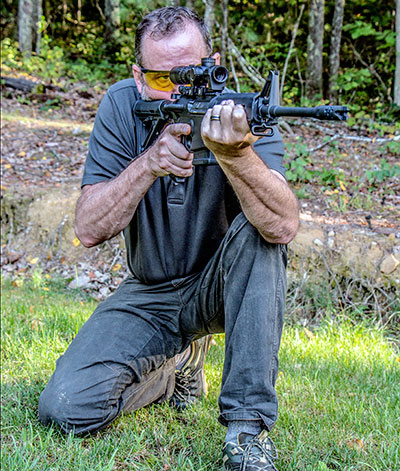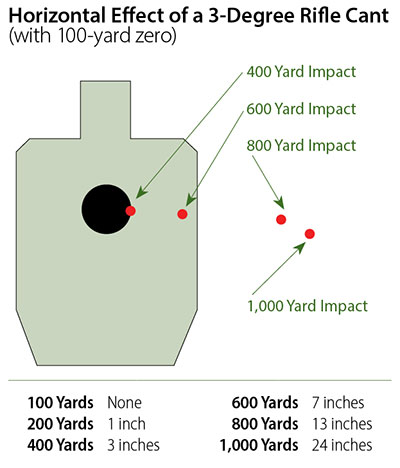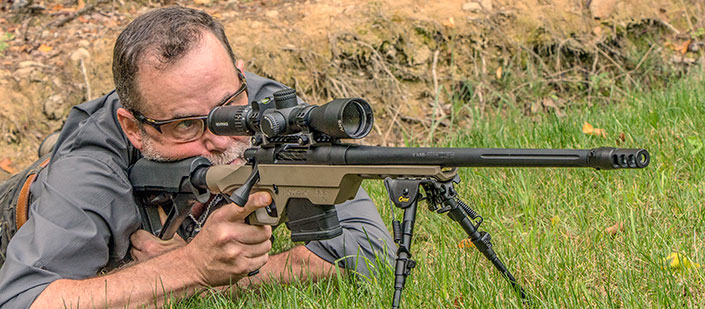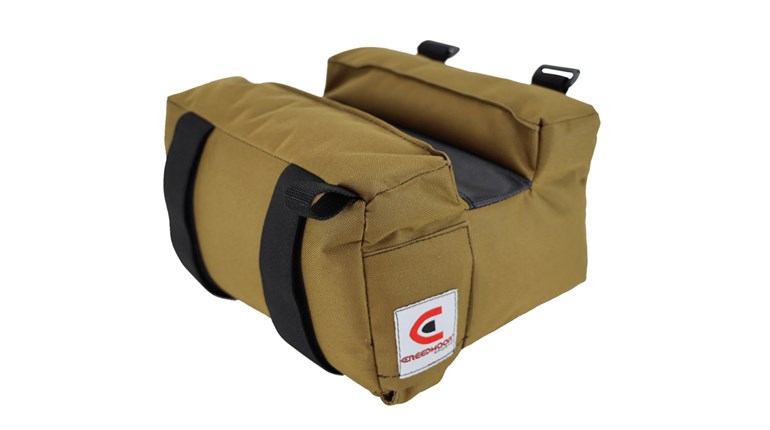
Grandpa used to say, “Can’t never could do anything.” He was right, of course, but “cant” can cause you a lot of problems when it comes to shooting—particularly at long range. That high-dollar rifle, fancy scope and precision-handloaded ammunition work best when the playing field is leveled. But, leveling everything off is not as easy as it might seem.
As it relates to shooting, cant is defined as: to set at an angle or to pitch to one side. It is most commonly used to describe a situation where the shooter is positioned on a slope and the rifle is not held vertically true or straight up an down. In other words, if you look through the riflescope, the horizontal crosswire is not level. Cant is not to be confused with line-of-sight (LOS), such as when you are shooting up or downhill. There are three types of cant rifle shooters must deal with: rifle cant, scope cant and reticle cant.
 Trajectory
Trajectory
First, you must understand trajectory. When a bullet leaves a rifle’s barrel, gravity immediately takes effect. We compensate for trajectory by adjusting the scope’s reticle to intersect with the trajectory of the bullet at a certain range. Usually, this is at 100 yards. For shooting at longer ranges, we adjust the reticle using the elevation turret or by aiming with the stadia marks or indicators on the lower vertical portion of the reticle. But, if our aiming point—regardless of where it is or which one we use—is not plumb with the centerline of the rifle’s bore and the trajectory of the rifle, our shots will land to the left or right of where we aim.
Using the trajectory of a 168-grain, .30-caliber bullet, with a ballistic coefficient (BC) of .462 and muzzle velocity of 2,681 fps, let’s examine the effects of these different cants. Our imaginary rifle will have the scope mounted 1.8 inches above the centerline of the bore, and we’ll trust the calculations of the smartphone Ballistics AE app. To simplify, we’ll also use common atmospheric conditions, assume there is no wind and round up to whole numbers.
 Rifle Cant
Rifle Cant
On the shooting range, cant is not often a big deal because most ranges have flat shooting positions—in the field is where it becomes a problem. The solution is to utilize a bipod with adjustable legs or, better yet, a bipod that swivels. According to Brian Litz’s book, “Accuracy and Precision for Long Range Shooting,” humans can look through a riflescope and recognize if it is canted more than 3 degrees. This might seem like enough to sort out the problem. It’s not.
With zero rifle cant, our referenced bullet will drop 405 inches at 1,000 yards. With a 3-degree rifle cant, it will drop about 407 inches. That difference is negligible. However, that 3-degree cant equates to a horizontal point-of-impact variance of approximately 24 inches at 1,000 yards. Generally speaking, that’s a miss. The reason this is such a problem is that when you dial in your corrections on a canted rifle, you are moving the center of the reticle away—at a 3-degree angle—from the perfectly vertical line-of-flight the bullet follows.
You compensate for rifle cant by installing a level on your scope. Many manufacturers offer them. They attach around the scope tube, either as part of the ring or kind of like a reverse scope ring, and position a bubble level so you can see it easily from behind the rifle. Some long-range scopes even have internal bubble levels. A scope level might not completely eliminate cant, but it is much more effective than your eye. Rifle cant is shooter-induced and field-correctable. If you know the amount of cant, the Ballistics AE program can tell you the compensation. However, determining the exact degree of cant is quite difficult.

Scope Cant
Riflescope cant is similar to rifle cant, but is integral to the weapon system. It occurs when the scope is not mounted level with the rifle. This is reasonably common, because mounting a scope level to your rifle’s barrel requires tools many shooters don’t have at home. If a scope is mounted with a 3-degree cant, the downrange effect is similar to a 3-degree rifle cant.
Since most riflescopes have turrets or turret caps, which are flat, this is a relatively easy problem to overcome—if you have the right tools. First, secure your rifle so the scope bases or rail are level from side to side. Then, mount the scope, but, before tightening the rings, place another small level on top of the elevation turret. Twist the scope tube until the bubble is level and then lock everything down. If you plan on attaching a scope level to the scope—and I strongly suggest you do if you plan to shoot past 400 yards—this is the time to do that, as well.

Reticle Cant
The final cant problem is one you might not know about. Reticles are installed in riflescopes by human hands. The only thing this guarantees is a high probability of error. In almost every riflescope manufactured, the reticle is not perfectly plumb with the adjustment turrets. Most manufactures hold that tolerance to within 5 degrees. Out to around 300 yards—the distance within which most people shoot—that error will be hardly noticeable. Leupold has an off-plumb reticle tolerance of 3 degrees for all of its scopes except the high-end Mark 6 and Mark 8s, which are allowed a maximum of 1 degree. Nightforce has a reticle-cant tolerance of .5 degree for every scope it builds; that’s right, the company mandates all its optics to be at most .5 degree off.
If your riflescope is level, reticle cant is not that important unless you use the reticle for major long-range windage and elevation corrections. This is because when you adjust for correction with the turrets, you move the center of the reticle. If your scope is level, the turrets will move the center of the reticle in a true up or down and right and left direction. However, if you make the correction with the reticle and it is not plumb, you will induce lateral error into your aim at about the same rate that it would occur if your scope were not level.
 You cannot adjust out reticle cant, but you can compensate for it if you know it exists. This is accomplished by placing the rifle in a fixed and level rest. You’ll need to hang a plum bob at about 50 yards. I suggest you use something with a brightly colored string. Next, place a small level on the elevation turret and level the scope in the mounts. Then, look through the scope to see if the reticle’s vertical post is true with the plumb bob string. If its not, rotate the scope tube until it is. When that’s done, tighten everything down.
You cannot adjust out reticle cant, but you can compensate for it if you know it exists. This is accomplished by placing the rifle in a fixed and level rest. You’ll need to hang a plum bob at about 50 yards. I suggest you use something with a brightly colored string. Next, place a small level on the elevation turret and level the scope in the mounts. Then, look through the scope to see if the reticle’s vertical post is true with the plumb bob string. If its not, rotate the scope tube until it is. When that’s done, tighten everything down.
You must keep in mind that even though your reticle is now level, your scope may not be. Let’s assume your reticle was 3 degrees out of plumb and you mounted the scope so the reticle was level. Any adjustments now applied with the windage and elevation turrets will induce that 3-degree error because the reticle is still three degrees out of plumb with the adjustments. It was made that way; you cannot fix it.
By now you’re probably wondering how anyone hits anything at long range.

Practical Application
Successful long-range shooting is a matter of inches. As a shooter, you will induce error (inches) into every shot, so it only makes sense to start with a system that is as error-free as possible. If you’re going to shoot from anywhere other than a shooting bench, a scope level is necessary, and it must be properly installed (level with the scope). If you are going to dial in your corrections, the scope itself must be level, and if you’re going to make major corrections with the ballistic marks integral to the reticle, the reticle must be level inside the level scope.
The approach that makes the most sense is to use a swivel bipod, level the scope turrets with the rifle, install a scope level, and then make all major corrections with the turrets. Small corrections of one mil or less, to compensate for wind changes or incorrect range estimation, will then only have minimal impact on your shot. With a shooting system so configured, given a 3-degree reticle cant and using our sample bullet, applying a 1-mil or 3.5-MOA correction at 1,000 yards will only induce a point-of-aim/point-of-impact error of about 3 inches.
Its still always a good idea to check and see how out of plumb or level your reticle is with your scope turrets. If I paid more than a grand for a long-range riflescope and found the reticle to be more than a single degree out of plumb, I’d be upset. I’d return that riflescope and demand my money back, or at the very least a replacement. After all, cant shouldn’t be part of a long-range shooter’s vocabulary.





































